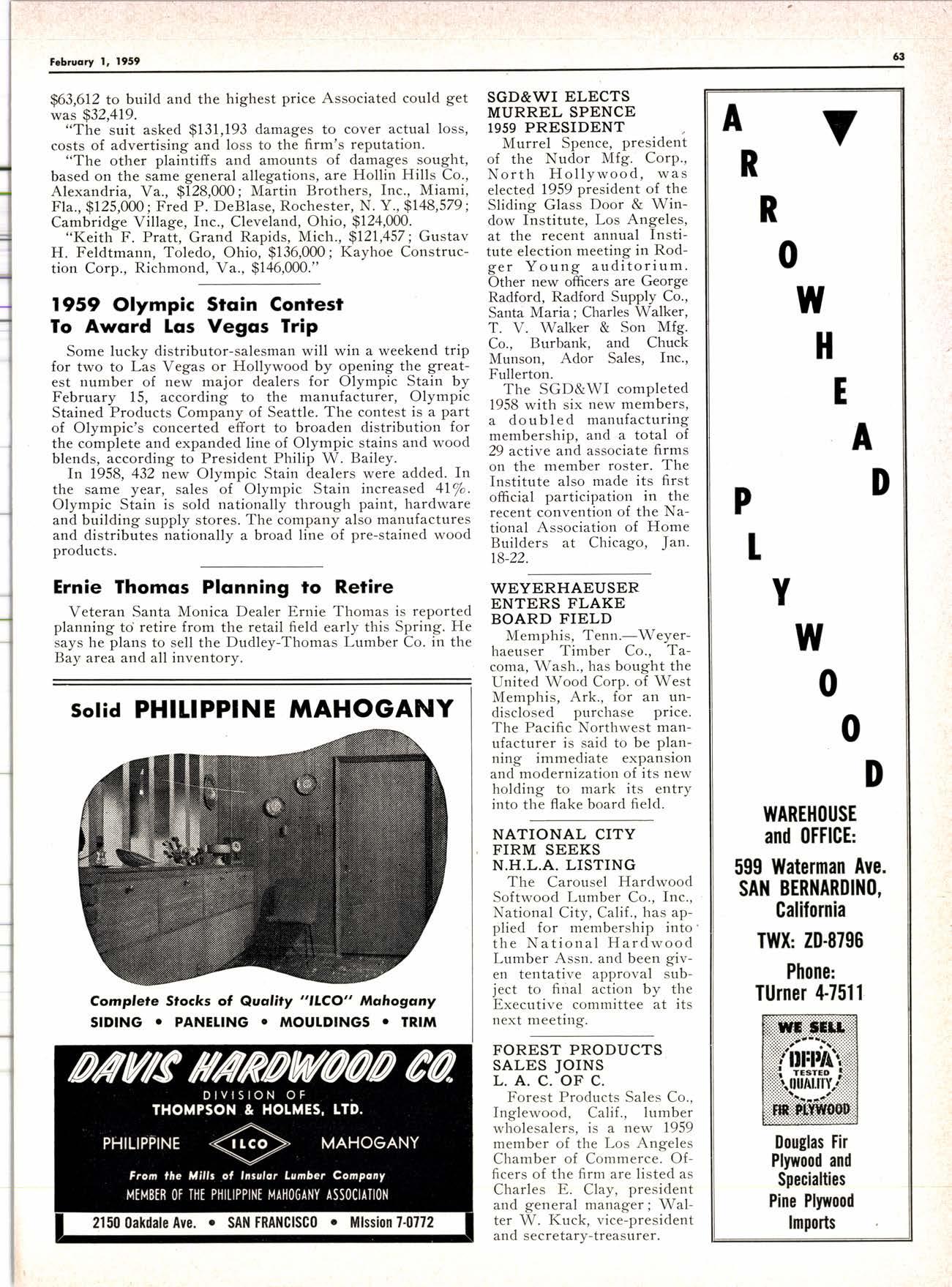
3 minute read
Colifornio Wood Products Into New Sonto Roso Plont
Climaxing six years of rapid growth as one of the West's largest manufacturers of solid and grid core doors, folding doors and sliding doors, California Wood Products, Inc., moved in December to its new, completely modern plant in the Rohnert Industrial Park area near Santa Rosa, California. The Cal-Wood plant was one of the first buildings to be completed in this huge industrial park located in this rapidly growing industrial area north of San Francisco Bay.
With almost 50,000 square feet of production area, the plant will employ an average of 50 workmen and provide a daily production capacity of 2500 completed units. Anticipating a continuing and growing demand for home and commercial buildings throughout the country, the new CalWood plant is designed with knock-out wall panels to permit quick, easy expansion when the need arises.
NWP railroad spur track to the loading platforms and 101 State Freeway adjoining make possible better and faster shipping service to customers by rail or motor freight to all parts of the United States.
Cal-Wood was formed in 1952 by E. M. "Bud" Critchfield, who, with the aid of one helper, began producing a grid core door to supply the needs of local distributors. During the next few years, the young firm continued to grow and expand. It was in this period that much of the machinery, including a grid core assembly machine, was designed and built by Bud Critchfield and his employes. Many of these labor and time-saving machines are still unique in the industry.
In six years, the plant had spread to fill seven buildings of assorted shapes and sizes in the Sonoma County Airport area. A major portion of all types of doors for such projects as the Lakewood home tract development in Los Angeles, Fort Ord Units 1 and2. Travis. Beal and Klamath Falls Air
Force Bases have been supplied by the company out of those buildings.
The 15-mile move into the new, integrated manufacturing facility was accomplished with very little loss of production by following a tight schedule of pre-arranged partial shutdowns and quick moves.
After heavy stockpiles had been developed at the old plant, lumber production was stopped and that department moved to the new location to start stockpiling there. Lamination and finishing departments cohtinued operation at' the old plant until the lumber stockpile was exhausted. Careful timing then enabled the completion of the bompany move to the already created lumber stockpile in the new Iactory.
Productive time lost in the entire move was measurable in hours. All other related operations were scheduled to coincide with the two major movements without time loss.
The firm is now supplying all models of its doors to any part of the United States where a need exists for low-cost doors of exceptional quality in relation to price. Contractors and dealers are invited to visit the new California Wood Products plant and become familiar with the novel production methods that have more than doubled the company's volume each year for the past five.
1958 Gensus of Business
The 1958 Census of Business Form CB-52-1 will be sent to all lumber and building material dealers. Filing of this form is mandatory. The report is required by Act of Congress. Census Bureau advises that it is their intention to go back on any dealer who leaves out some of his figures as called for in the form.
Where the form calls for either a dollar figure, or a percentage figure, the dealer should fill in his best estimate if his records do not provide the exact amount, reports the Southern California Retail Lumber Association.
The designations "Lumber Yard" and "Building Material Dealers," as well as the lumber wholesaler without yard and lumber distributor with yard, are included among the several other classifications in paragraph 13 (a) "Kind of Business." So that dealers may more accurately describe this type of business, "Wallboards" and "Roofing Materials" have been included in the revised "Lumbei Yard" category No. 211. Formerly those classifications were under the Building Material Dealers (212) category.
In previous years, Census used the rule of "Over 50/o" to determine whether a firm was a lumber dealer or hard material dealer, based on the product he handled.
In view of shifting Wallboard and Roofing to the Lumber Yard category (while these items are not included with the forest products in Question 13 (b) (1)), if this figure should show up 35/o or more, the firm will be classified as a Lumber Yard.
Census Bureau expects to make a special analysis of this question to determine the number of dealers, in graduated percentage breakdowns, showing the percentage of lumber products handled in relation to other building materials.
NIMA Hqnd-Picks Hodges
Ralph Hodges, 38, industrial forester with 72 years' experience in forest management for lumber, plywood and pulp-paper companies in the West, has been appointed director of the Forestry and Economics division of the National Lumber Manufacturers Association, Washington, D. C. He succeeds A. Z. Nelson, named director of NLMA's Industry-Government Affairs division.
From 1946 to 1950, Hodges held forestry positions with R-ayonier, Inc., _Sapho, \Mash. ; the forest engineering firm of Porteous & Co., Seattle, and the Harbor Plywood Corp.,
Lewis River, Wash. He served as California District Forest engineer for the Western Pine Association, Portland, Ore., from 1950 to 1955 and since then has been employed as forester for the Wetsel-Oviatt Lumber Co. with opeiations in central and southern California. Hodges' background includes a broad knowledge of federal timber sales procedures. A veteran of World War II, he holds a bacfielor's degree in forestry from the University of California.


![BONNINGTON LI]DIBBB OO.](https://assets.isu.pub/document-structure/230727201647-e018b83b14248a9d6490fd9e237f3f12/v1/114f9eff88a705bf7440406fb181c718.jpeg)








